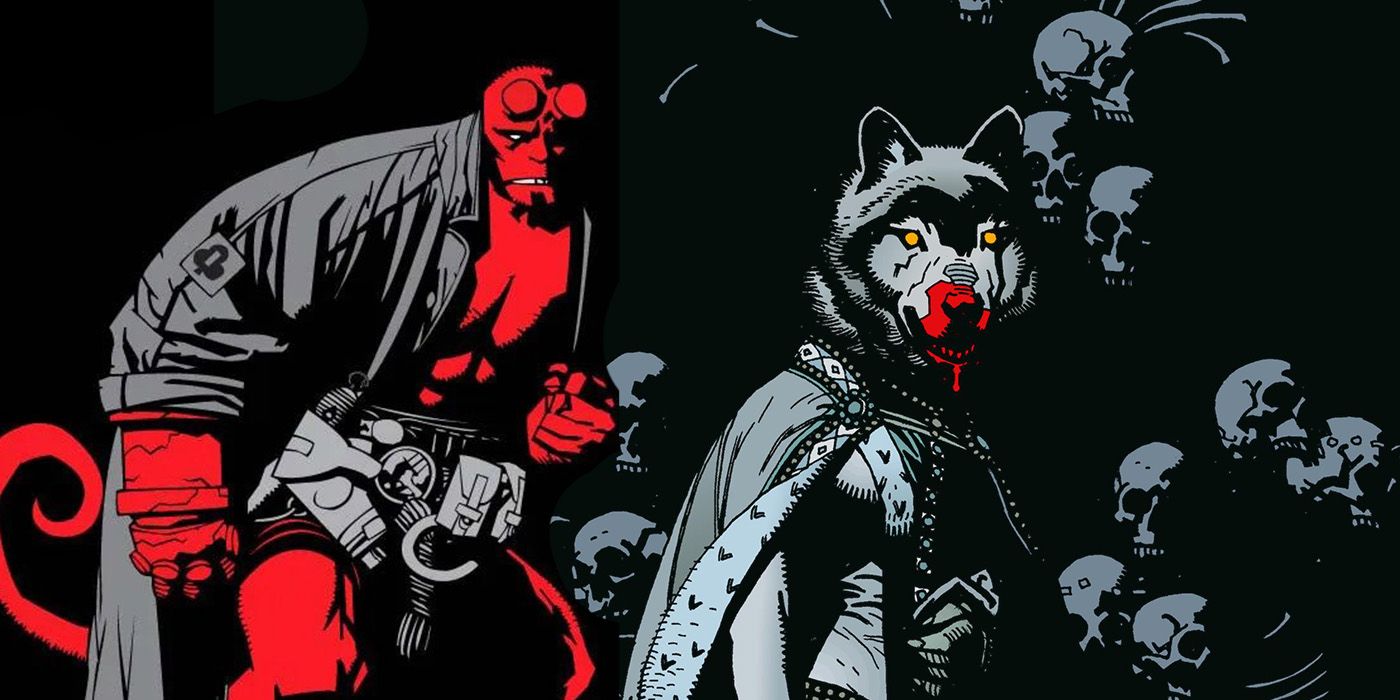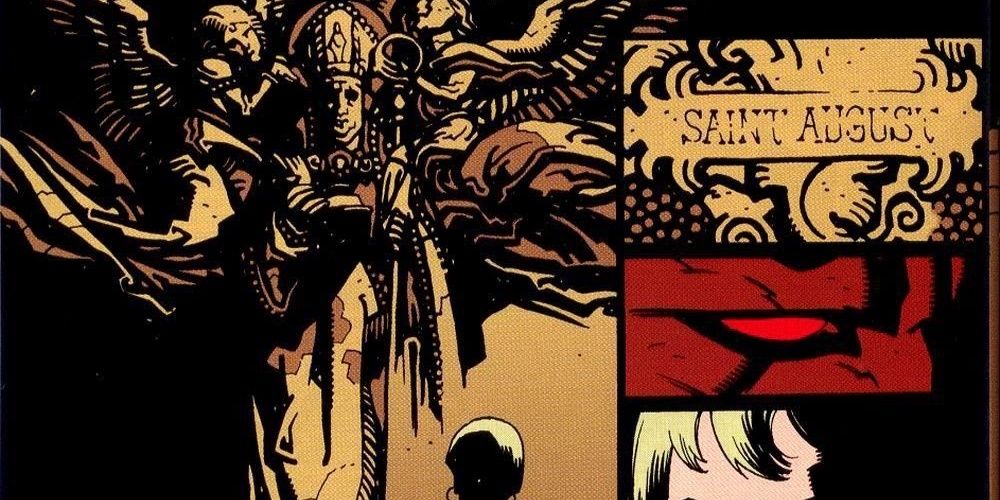This article is part of CBR's 31 Days of Halloween Event. Read the rest here!
Halloween can be many things, but for some, it is time to bundle up in a cozy corner with a horror comic and visit the dank, dark corners of the Earth. And what better way to do that than with a Hellboy comic book in hand as the demon-prince-turned-paranormal-investigator comes across terrifying secrets and blood-curling folklore that come to life once in a while? Among the most harrowing tales in Hellboy mythos is The Wolves of Saint August. A four-part miniseries that ran in Dark Horse Presents soon after the Eisner-winning acclaim of Hellboy: Seed of Destruction, it is the perfect spooky companion for those looking for blood and bones.
Hellboy: The Wolves of Saint August was Mike Mignola's first attempt at handling a full script of a Hellboy story away from the tutelage of John Byrne, providing a different spin to the ye old werewolf formula. Instead of howling wolves who transform at the sight of the full moon, it gives readers a terrifying look at curses and haunted spirits, making the book an instant Halloween favorite for those brave enough to enter the condemned hamlet. As part of the 31 Days of Halloween celebrations, CBR takes a deep look at horror classics, this time taking Hellboy for a spin.
The Werewolf Curse Infects Hellboy: The Wolves of Saint August
Lycanthropy enjoys a special place in European medieval folklore with its more widespread beliefs and tropes made popular by modern werewolf fiction. But one common thread that connects stories new and old is a werewolf's accursed nature. Hellboy: The Wolves of Saint August thus finds itself rooted in two worlds - one with a dark history of witch trials and superstitions, while the other shows the terrifying reality of trauma on a soul. The story takes place in 1994 in a sleepy Eastern European town where a priest arrives to hold services. But when the whole village turns up dead, including the clergyman himself, Hellboy and Kate Corrigan take up the investigation as all clues lead to a werewolf massacre. By Mignola's own admission, the book's premise takes inspiration from an Irish legend involving St. Patrick and a pagan-worshipping clan. Hellboy: The Wolves of Saint August is tailor-made for readers who like to dip their toes in forbidden occult lore and supernatural tales, especially for those with a predilection for monster horror that acknowledges the tragedy of a monster's being.
Therein lies the emotional basis for the entire tale. Although a footnote to the blood-soaked mystery and the frenzied fisticuffs between Hellboy and the beast, the sad origin of the curse and its existence centuries later is the cause of much of the conflict in the book as well as the sorrow for many a character. For readers looking beyond the mythical aspects, Hellboy: The Wolves of Saint August gives them a dark past to ponder upon. Only Mignola can interject the big action sequence with passages of the folklore of Saint August that taints the town of Griart. It almost sounds like a recitation of a medieval ballad and gives the final act a fittingly poetic touch. But he leaves no such compassion for the story's antagonist. A wolf in a man's costume, the revelation of William Grenier's evil machinations may not come as a shock, for there are signs everywhere. However, his utter disregard for innocent lives on whom he enacts his anger will make the reader fume and root for Hellboy's victory, knowing not that the story has roped them in out of nowhere.
Mike Mignola's Inks Bring Out The Darkness in Hellboy: The Wolves of Saint August
The Hellboy universe is known for its gritty tales and fantastical themes, where the pulp and Lovecraftian influences are plain to see in Mike Mignola's storytelling, be it the script or the art. Hellboy's tussles with mythical monsters and other untold horrors generally put his adventures in the monster horror archetype. But Hellboy: The Wolves of Saint August not only fits the genre but also embraces it, warts and all, creating a memorable addition to werewolf fiction already saturated with thought-provoking pieces of media. Mignola takes back werewolf lore to the medieval age when Christianity condemned age-old pagan worship prevalent in ethnic tribal groups and distant regions of Europe, thinking it similar to satanic rituals. Whether due to ignorance or to spread their own religion, the history of condemnation from the church lays down the groundwork for the story. But if Hellboy: The Wolves of Saint August feels gothic, it is because of the Transylvania-like feel of the town of Griart, where a stream of blood flows from the crypt of an old castle turned into a house of worship. No wonder it will remind horror comic fans of a certain famous vampire's abode.
Mike Mignola's artwork is the reason behind the hauntingly beautiful atmosphere of the book. His inking creates long shadows that hang like an overcast over Griart and its people. Oftentimes, it does not take much to hint at the sinister nature of the tale. Just the silhouettes of the characters and faces in the dark are enough to creep out people. But not everything is an evil. Like the ghost of a little girl standing in the darkness, weeping as they turn into a werewolf. Or when William Grenier tears open his human flesh to reveal the beast within, his feral features finally corroborating his vile nature - these images sear into one's mind and stay there forever. Hellboy: The Wolves of Saint August does not need jump-scares to induce horror. Mignola uses the architecture to create enclosed spaces to trap Hellboy and Kate. As the two BPRD personnel get surrounded by werewolves, their blue eyes glowing in the dark as their dead victims' spirits ask for deliverance, the book immediately turns a grave corner, with the many rock statues of saints and the son of God as witness.
Hellboy: The Wolves of Saint August Helped Create The Mignolaverse Of Stories
Hellboy: The Wolves of Saint August was Mike Mignola's way of showing his reader base that he was serious about expanding the world of Hellboy. In that, not only did the book make inroads into a rich universe of overlapping stories but also laid down the foundations of what fans call the 'Mignolaverse'. From iconic figures to new spin-off titles, Hellboy soon became the go-to horror comic for fans as they became increasingly invested in Big Red's journey to abdicate himself from his role as the world-destroyer. Loosely based on the legend surrounding the Werewolves of Ossory, Hellboy: The Wolves of Saint August's actual plot revolves around the Irish folklore about how St. Patrick cursed a group of pagans, and every seven years, they would turn into wolves. Much like the original tale, where the werewolves were actually a line of kings, Mignola turns the royal family of Grenier into the hapless victims of the curse. Either way, the Hellboy story does not forget to show how the aftermath of religious orthodoxy can change the course of history and lives.
Mike Mignola has, on record, called himself a terrible inker who would loiter the halls of Marvel for freelance work when deadlines were tight. While it is a harsh, self-deprecating look back at one's career, his unique style is now synonymous with dark, eldritch horror comics. Before coming up with his groundbreaking Hellboy series, Mignola had already made his mark on the comic book industry with Marvel's Rocket Raccoon and DC's Cosmic Odyssey, with Gotham by Gaslight being one of his noteworthy works for the latter publisher. He continued that gothic horror style into the comic book adaptation of Francis Ford Capolla's 1992 cult classic Bram Stoker's Dracula. If anything, Hellboy: The Wolves of Saint August is where Mignola shows off his refined craft and worldly knowledge of the various folklores and tribal legends. It also gave him a chance to expand Hellboy's past from Nazi occult and Lovecraftian terrors to more bestial and baser horrors that are more ancient than some empires themselves.
Not just hardcore Hellboy fans looking to have a readathon through the month of October but also casual readers who love to turn on some monster horror for Halloween would find Hellboy: The Wolves of Saint August to be a spine-chilling affair. But those looking for misunderstood creatures and star-crossed love would find themselves in the wrong place. For in this festering darkness, there is only animalistic rage and cursed anger. A classic Hellboy story from start to finish, Hellboy: The Wolves of Saint August may skimp on the gorefest, but its poetic nature can bring out the emotions with its timeless tragedy.




